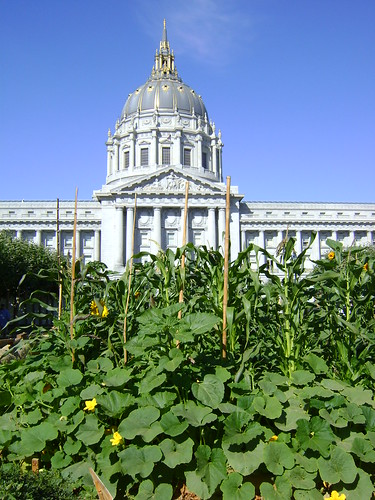
Photo: From Slow Food Nation page on Flickr
It's been nearly two weeks now since returning from Slow Food Nation in San Francisco and I haven't had a minute to digest my thoughts. The food, though, was long ago digested, pleasantly.
By now you've probably read the media (to pick just one article) and blogs (here, here, here and here) on the event, seen some of the videos of the panels, or just caught a passing reference to what went down in the city's Civic Center. It was quite a bash, crowded with people, food, and thought. I participated in a "changemakers day" session that brought non-profits, business people and farmers, many of them from California, to discuss altering the way food is grown, distributed, sold, and eaten.
Outside the auditorium and conference rooms, the action was unfolding on the plaza, with alluring aromas and a very wonderful garden. An official at the city's environment department told me that normally this was just a lawn, but repurposed into a garden, people were finally inhabiting the space. Yes, gardens are inviting. The city was considering keeping it there, if the idea could make it through bureaucratic hurdles.
There were food stands on one side of the plaza and an impromtu farmers' market on the other, with the garden inbetween. I scarfed down sausage and peppers (just shy of the requisite grease you might find in NYC), an Asian pork noodle dish, grass fed beef hot dogs, and fruit from the farm stands (one of the best peaches of the year). All of it tasty. Not frozen, packaged, or precooked, but the real deal. My only complaint was the lack of whole grains, beans or veggies. They seemed consigned to show off in the garden and farmers' market.
Another slight beef -- the pace of Slow Food. Spying a dish of hand pulled noodles, I asked someone where he had purchased it. He pointed to a stand. "We waited 60 minutes to get it, but it's very good!" he said optimistically.
Demand for this type of food, that is, good, home-made food, far exceeds the supply -- and that was evident even in these wonderful small food tents. But I feared that people unfamiliar with Slow Food would literally end up thinking that the term described the time it took to get the food rather than the values behind it. ("Oh, that's why it's called slow food!")
As for the public seminars, the ones I attended were quite good and thought provoking. The Slow Food movement is at something of a turning point, trying to redefine itself beyond the gastronomic ghetto which for too many just means rarified and expensive foods. That isn't what Slow Food is about -- it is a movement based on a political premise of good, clean, fair food -- but that political message at times gets lost in the very well-made sauce. Again, because the sauce is hand-made with love.
Eric Schlosser, the Fast Food Nation author, brought this up, when he implored the audience to recognize the workers in the fields and kitchens. Vandana Shiva, the Indian food activist, also repeatedly tried to draw the connections between what was happening in the wealthy northern hemisphere and what was happening in the poorer south. So the sentiment, the acknowledgment of the social dimension of food choices was clearly there, but it was a message brought up by “us” about “them” -- the "them" being those who did not appear at the gathering.
Could Essayist Wendell Berry’s call for a more “neighborly” approach, in which everyone in a community helps each other, widen the circle? Slow Food clearly had this issue in mind, as evident in this background essay by organizer Anya Fernald at the Slow Food Nation blog, but it still has more work to be done.
"We’re Eating Oil”
One theme that ran through the talks was the dead-end of the modern farm agro-economy. Michael Pollan, being Michael Pollan, distilled this thought by saying “we’re eating oil.” The entire food economy has been built on cheap oil, and if that changed, so too would farming and food. Oil and natural gas are used to make the fertilizers, run the machinery and distribute food globally.
The other variable out there is global warming. Here, Wes Jackson of the Land Institute in Kansas pointed out that the rise in temperature might not be the biggest factor in climate change. Rather, it might be the unpredictability of weather. In the Midwest, it was the rains, which right now are coming very powerfully and washing away top soil and leaching fertilizers into the Mississippi river and the Gulf of Mexico. Rain might make the Dust Bowl look tame in comparison since water is a far more powerful in pulling away soil than wind. And wind, you'll recall, picked up top soil off the prairie and darkened the midday skies of New York City in the 1930s.
Not a happy thought. But I'll leave you with this, the flip side of Slow Food that is very easy to digest. I think I might have had the best pizza I've ever eaten over at the Taste Pavilions. And ditto for the ice cream. I think the idea here is that the same values producing this food are the ones that will keep food production close at hand, working with taste and nature, and preventing the dust (or rain) bowls of the future. I'm not sure that message came with the ice cream but it was there if you took in the full circle of the experience.
- Samuel Fromartz

